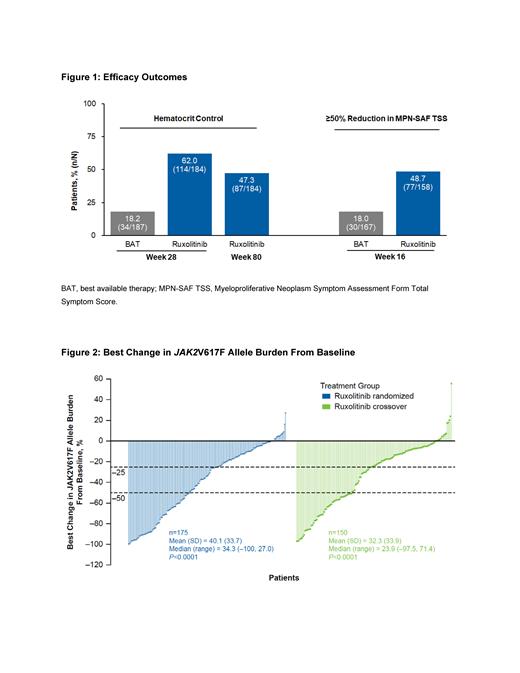Introduction:In the pivotal RESPONSE and RESPONSE 2 trials, the Janus kinase (JAK)1/JAK2 inhibitor ruxolitinib was superior to best available therapy (BAT) at providing hematocrit control and complete hematologic response, as well as in improving disease-related symptoms, in patients with polycythemia vera (PV). Here we report the results of a post hoc pooled efficacy analysis using data from the RESPONSE studies.
Methods:RESPONSE and RESPONSE 2 were randomized, open-label, multicenter phase 3 trials that assessed efficacy and safety of ruxolitinib in adults with PV who had resistance or intolerance to hydroxyurea. Splenomegaly was required for enrollment into RESPONSE but not for RESPONSE 2; patients in both studies were randomized 1:1 to ruxolitinib (starting dose, 10 mg twice daily) or BAT (most commonly hydroxyurea [59%, 49%] or interferon formulations [12%, 13%] in RESPONSE and RESPONSE 2, respectively). Patients in either trial who were randomized to BAT could cross over to ruxolitinib at the time of primary analysis (Week 32 in RESPONSE; Week 28 in RESPONSE 2) or later for efficacy or safety reasons. In this pooled analysis, hematocrit control was assessed in the pooled population at Weeks 28 and 80 and was defined as hematocrit <45% that was maintained since Week 16 with ≤1 phlebotomy occurring postrandomization and before Week 4. Symptom control (using the Myeloproliferative Neoplasm Symptom Assessment Form Total Symptom Score [MPN-SAF TSS]) and changes over time in JAK2V617F allele burden were also assessed. Response rate 95% CIs were calculated using the Clopper-Pearson exact method, and the odds ratio (OR) and 95% CI for comparisons of the proportion of patients achieving ≥50% reduction from baseline in MPN-SAF TSS were calculated by the Mantel-Haenszel method.
Results:Overall, 371 patients were randomized in RESPONSE and RESPONSE 2 (ruxolitinib, n=184; BAT, n=187). Patient baseline characteristics were similar across trials and treatment groups and have been previously published. Mean (SD) age in the overall pooled analysis population was 61.8 (11.0) years; most patients were male (62.5%) and White (88.1%). At Week 28, 62.0% (95% CI, 54.5%-69.0%) of ruxolitinib patients achieved hematocrit control compared with 18.2% (12.9%-24.5%) of BAT patients (Figure 1). Durable hematocrit control was maintained to Week 80 by 47.3% (95% CI, 39.9%-54.8%) of patients randomized to ruxolitinib (nearly all patients in the BAT arm crossed over to ruxolitinib). The percentage of patients achieving ≥50% reduction from baseline in MPN-SAF TSS at Week 16 (the only common timepoint in both studies) was higher for ruxolitinib vs BAT (48.7% [95% CI, 40.7%-56.8%] vs 18.0% [95% CI, 12.5%-24.6%]; OR, 4.3 [95% CI, 2.6-7.2]). Mean (SD) change from baseline to Week 16 in MPN-SAF TSS was −4.4 (10.0) for ruxolitinib patients and 0.6 (6.9) for BAT patients. JAK2V617F allele burden decreased consistently from baseline to Week 208 in patients randomized to ruxolitinib. Mean JAK2V617F allele burden decreased from 66.1% to 41.4% at 4 years. Best change from baseline in JAK2V617F allele burden is shown in Figure 2, with a decrease of ≥25% in 57.1% of patients randomized to ruxolitinib and ≥50% decrease in 38.9%. Similar reductions in JAK2V617F allele burden were observed following crossover from BAT to ruxolitinib (Figure 2), with a best decrease of ≥25% and ≥50% in 48.7% and 35.3% of patients, respectively. Analysis of the BAT group is limited by small patient numbers after Week 32, as most patients crossed over to ruxolitinib, with a best decrease of ≥25% and ≥50% in 7.2% and 2.6% of patients respectively.
Conclusions:In this pooled analysis of RESPONSE and RESPONSE 2, patients with PV treated with ruxolitinib achieved durable hematocrit control through Week 80 and had better symptom control at Week 16 than those who received BAT. Reductions in JAK2V617F allele burden were consistently observed through Week 208 in patients treated with ruxolitinib, including those who crossed over from BAT. Taken together, these results provide further evidence of the patient benefit of ruxolitinib in patients with PV with or without splenomegaly.
Disclosures
Harrison:GSK: Honoraria, Speakers Bureau; CTI: Honoraria, Speakers Bureau; AOP: Honoraria, Speakers Bureau; Abbvie: Honoraria, Speakers Bureau; Galecto: Honoraria, Speakers Bureau; Novartis: Honoraria, Research Funding, Speakers Bureau; BMS: Honoraria, Speakers Bureau; Morphosys: Honoraria, Speakers Bureau. Kiladjian:Incyte Corporation: Membership on an entity's Board of Directors or advisory committees; BMS: Membership on an entity's Board of Directors or advisory committees; AOP Orphan Pharmaceuticals: Membership on an entity's Board of Directors or advisory committees; Abbvie: Membership on an entity's Board of Directors or advisory committees; Novartis: Membership on an entity's Board of Directors or advisory committees; AbbVie, AOP Health, Bristol-Myers Squibb, GlaxoSmithKline, Incyte, Novartis, Pharmaessentia.: Consultancy. Palandri:Novartis, BMS, Celgene, GSK, Amgen, AbbVie, Karyopharm, AOP, Sierra Oncology, Janssen: Consultancy, Honoraria. Hamer-Maansson:Incyte Corporation: Current Employment, Current equity holder in private company, Current holder of stock options in a privately-held company. Braunstein:Incyte Corporation: Current Employment, Current equity holder in private company, Current holder of stock options in a privately-held company. Passamonti:AbbVie, Janssen: Honoraria.


This feature is available to Subscribers Only
Sign In or Create an Account Close Modal